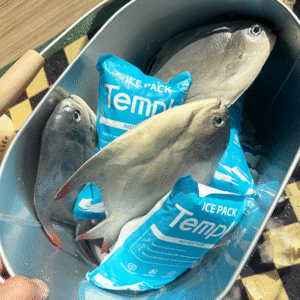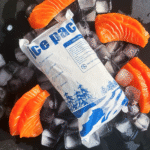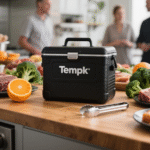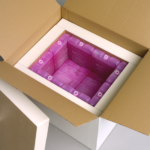Dry ice packaging and dry ice pack sheets solve a common cold chain challenge: how to keep products frozen without leakage or mess. Dry ice is solid carbon dioxide that sublimes into gas rather than melting to liquid, making it ideal for shipping frozen foods, vaccines and lab specimens. These insulated solutions maintain ultra low temperatures and simplify clean up. As you plan your shipments, you want to know how dry ice packaging works, what makes dry ice pack sheets different from gel packs, and how to handle these materials safely. This guide combines industry knowledge with 2025 SEO best practices to keep your shipments and your website ranking at the top.
Apa yang membuat kemasan es kering Dan lembar paket es kering essential cold chain tools?
How do you select the right kemasan es kering for foods, pharmaceuticals and other products?
What safety and regulatory guidelines must you follow when shipping with dry ice?
How can you compare dry ice pack sheets with gel packs or other coolants?
What innovations and trends should you watch in cold chain packaging in 2025?
Why Choose Dry Ice Packaging for Shipping Perishables?
Dry ice packaging provides a simple and reliable way to keep cargo extremely cold while avoiding the mess associated with melting ice. Dry ice does not melt; it sublimes directly from a solid into carbon dioxide gas. This means shipments remain dry, with no water pooling in your box or cooler. Bila digunakan dengan benar, dry ice packaging maintains temperatures as low as – 109 °F (approximately – 78 °C) for hours or even days, depending on the insulation.
How Does Dry Ice Packaging Work?
Dry ice packaging uses an insulated container lined with material that allows the carbon dioxide gas to escape safely. The dry ice inside gradually sublimates, absorbing heat from your products and maintaining low temperatures. Containers are usually made of expanded polystyrene foam (Styrofoam) placed within a corrugated cardboard box. This dual-layer design provides strength and insulation while allowing ventilation.
Sebaliknya, traditional ice melts and creates liquid water; gel packs absorb heat and eventually become warm. Dry ice packaging keeps items below freezing for longer, membuatnya ideal untuk:
Makanan beku: hidangan laut, daging, es krim, meal kits and specialty baked goods benefit from sub-zero temperatures during transit.
Life sciences: vaksin, diagnostic specimens and pharmaceuticals often require shipment between – 70 °C and – 20 °C.
Industrial applications: shipping biological materials or lab reagents that must remain frozen.
What Are Dry Ice Pack Sheets and How Do They Differ from Gel Packs?
Dry ice pack sheets are flexible sheets containing pockets of dry ice or dry ice compound. They offer similar benefits to loose dry ice but are easier to handle. Itu sheeted design reduces direct contact with skin, which helps prevent frostbite, and it simplifies packing because you can cut the sheet to size.
Gel packs are reusable polymer-based packets filled with water or another cooling gel. They maintain temperatures around 0 °C and gradually warm to ambient temperature. Berbeda dengan paket gel, dry ice pack sheets maintain sub-zero temperatures and produce no liquid by-product. They are suitable for shipments requiring extremely cold conditions over shorter durations or where space is limited.
Choosing the Right Packaging: Faktor kunci
Product type and temperature requirements: Know the critical temperature range for your product. Misalnya, vaccines shipped on dry ice may require – 70 °C, while gourmet pastries may only need to stay below – 18 °C. Dry ice packaging and pack sheets are designed for ultra-low or low-frozen temperatures, whereas gel packs cover refrigerated ranges.
Waktu transit: Estimate how long the shipment will be in transit. Dry ice sublimates over time; plan the quantity to last the entire journey plus a margin.
Peraturan: Dry ice is a hazardous material classified as a Kelas 9 dangerous good with UN 1845. You must comply with shipping regulations including labeling, packaging and documentation.
Budget and sustainability: Consider cost per shipment, waste disposal and environmental impact. Dry ice is made from recovered carbon dioxide, but the manufacturing and packaging produce emissions. Reusable gel packs may be more economical for frequent shipments at moderate temperatures.
What Safety and Regulatory Guidelines Must You Follow?
Shipping dry ice requires knowledge of regulations and safe handling to protect workers, pembawa dan penerima. AS. Departemen Transportasi (DOT) dan Asosiasi Transportasi Udara Internasional (Iata) set strict guidelines for packaging, pelabelan dan dokumentasi.
Hazard Classification and Training
Dry ice is classified as a Class 9 miscellaneous dangerous good. Its proper shipping name is “Dry Ice” or “Carbon Dioxide, padat,” and its UN identification number is Dan 1845. Employees handling dry ice packages must receive hazardous materials (tanah air) training to ensure they understand the risks and procedures.
Dry ice shipments are regulated because they:
Create pressure: Saat es kering menyublim, carbon dioxide gas builds up. Containers must allow gas to vent; jika tidak, they could explode.
Displace oxygen: Carbon dioxide is heavier than air and can accumulate in confined spaces, posing a suffocation hazard. Ensure there is ventilation during storage and transport.
Cause cold burns: Dry ice sits at around – 109 °F. Contact with skin may lead to frostbite.
Persyaratan pengemasan
Labeling and marking: Packages must display the proper shipping name, Nomor PBB, the Class 9 label bahaya, and the net weight of dry ice in kilograms. Each package must be clearly marked with the shipper and recipient addresses and include a declaration that carbon dioxide gas will be released.
Batasan berat badan: Untuk transportasi udara, the net weight of dry ice per package is often limited to 200 kg (check your carrier for specific limits). Too much dry ice can create excessive pressure.
Dokumentasi: An air waybill or commercial invoice must list the UN number, number of packages and net weight. When shipping internationally, include import/export permits and other required documentation.
Packaging materials: Outer packaging should be durable and leak-proof. Use fiberboard or wooden boxes with insulation such as expanded polystyrene. Avoid sealed containers or materials that become brittle at low temperatures.
Ventilasi: The package must allow carbon dioxide gas to escape to prevent pressure build-up. This often means leaving a small vent or using containers designed to vent gradually.
Handling and Safety Tips
Peralatan pelindung pribadi: Kenakan sarung tangan terisolasi, goggles and face protection when handling dry ice. Use tongs or tools to avoid direct contact.
Ventilasi: Work in a well-ventilated area to prevent carbon dioxide accumulation. Do not use dry ice in confined spaces such as car trunks without ventilation.
Penyimpanan: Store dry ice in insulated containers but do not seal them; sealed containers may explode. Jauhkan dari anak-anak dan hewan peliharaan.
Pembuangan: Let leftover dry ice sublimate in an open, area berventilasi. Jangan pernah membuang es kering di wastafel, toilets or trash bins.
First aid: Treat frostbite caused by dry ice like a burn—warm the area with lukewarm water and seek medical attention if needed.
Following these guidelines protects you and ensures your shipments comply with regulatory requirements.
Comparing Dry Ice Pack Sheets to Other Cooling Solutions
| Solusi pendinginan | Kisaran suhu | Durasi khas | Liquid residue | Practical applications |
| Lembaran kantong es kering | – 109 °F to – 20 °F (kira-kira.) | 24–48 jam (depends on thickness and insulation) | TIDAK | Ultra-frozen shipments, space-limited packages |
| Loose dry ice pellets | – 109 °F to – 20 °F | 24–72 jam | TIDAK | Bulk shipments, durasi yang lebih lama |
| Paket gel | 32 °F to 41 ° f | 12–48 jam | Ya (when thawed) | Pharmaceuticals requiring refrigerated conditions, Makanan yang mudah rusak |
| Phase change material packs | Kebiasaan (ranges from – 5 °F to 20 ° f) | 24–96 jam | Minimal | Biologi, shipments with precise temperature control |
Advantages of Dry Ice Pack Sheets
Precise fit: They can be cut or folded to match the shape of your package, reducing empty space and ensuring uniform cooling.
Clean handling: Encased dry ice reduces direct contact and risk of frostbite.
Reduced risk of explosion: Most sheets incorporate micro-perforations or vent channels to release gas slowly.
Space efficiency: Sheets occupy less volume than loose dry ice pellets.
Improved user experience: Recipients can dispose of the sheet easily—just leave it in a ventilated area to sublimate.
When to Use Gel Packs Instead
Gel packs are better for shipments needing a refrigerated (tidak beku) suhu. Mereka dapat digunakan kembali, easier to store and handle, and pose fewer regulatory challenges because they are not classified as dangerous goods. Use them for products like fresh fruit, keju, or prepared meals that require temperatures above freezing. For ultra-cold shipments, Namun, dry ice packaging and dry ice pack sheets remain the preferred option.
Innovative Packaging Materials and Design Strategies
Bahan isolasi
Traditional dry ice packaging relies on expanded polystyrene (EPS) busa. While effective, EPS is not biodegradable and can be difficult to recycle. New materials are emerging:
Panel yang diisolasi vakum (VIP): Thin panels with extremely low thermal conductivity. They provide strong insulation in a smaller footprint but can be expensive.
Paper-based insulation: Some companies use corrugated cardboard combined with paper insulation made from recycled fibers. These solutions are compostable and reduce waste.
Biodegradable foam: Plant-based foams (MISALNYA., cornstarch foam) that provide insulation comparable to EPS but break down more easily in composting environments.
Sustainable Cooling Agents
Solid carbon dioxide from renewable sources: Some manufacturers capture CO₂ from biomass or industrial processes to make dry ice, reducing the carbon footprint.
Water-based phase change materials: Packaged in plant-derived plastics, these PCMs maintain stable temperatures around 0 °C without using petroleum-based gels.
Packaging Design for E commerce
The rise of e commerce has increased demand for small, lightweight packaging that fits through parcel lockers. Dry ice pack sheets help reduce package dimensions and weight. Some designs include separate compartments for food and dry ice, preventing direct contact and enabling consumers to remove the dry ice sheet easily upon delivery.
Smart Sensors and IoT Integration
Companies are incorporating temperature sensors and data loggers inside shipments. These devices record temperature and humidity throughout transit and transmit data via cellular networks or Bluetooth. Shippers and recipients can verify that the product stayed within the required temperature range. Di dalam 2025, expect more packaging to include Near Field Communication (NFC) tags atau Kode QR that allow customers to check the shipping history on a smartphone.
2025 Tren dan inovasi dalam kemasan es kering
The cold-chain sector continues to evolve as consumer demand for perishable delivery grows and sustainability concerns rise. Here are some trends shaping 2025:
Growth of Direct to Consumer Frozen Foods
Online grocery and meal kit services surged during the COVID-19 pandemic and continue to grow. Consumers expect restaurant-quality frozen meals delivered to their doorsteps. Dry ice packaging ensures products stay frozen during last-mile delivery. Companies are investing in compact dry ice pack sheets and better insulation to reduce shipping costs.
Sustainable Packaging Initiatives
Regulations and consumer preferences push companies to reduce waste and carbon emissions. Expect to see hybrid packaging combining dry ice with biodegradable insulation Dan reusable outer boxes. Some startups offer subscription programs where customers return insulated containers for reuse.
Improved Worker Safety and Automation
Robots and automated systems handle dry ice packaging in large fulfillment centers, reducing human exposure to extreme cold. Training programs focus on hazard recognition and proper use of personal protective equipment. Wearable tech monitors CO₂ levels and warns employees if ventilation is insufficient.
Integration with Cold Storage Logistics
Dry ice packaging is part of a broader cold-chain network. Warehouses and distribution centers use ultra-low-temperature freezers and automated picking systems to keep goods frozen until they are packed. Third-party logistics providers (3PLs) offer specialized cold-chain services, combining dry ice shipments with temperature-controlled vehicles.
Regulatory Changes
International shipping rules may change, especially after the pandemic’s lessons. There is a push to standardize documentation and training across countries, and carriers are implementing digital documentation to streamline compliance. Watch for updates from Iata dan International Civil Aviation Organization (ICAO) that may affect dry ice shipping.
Pertanyaan yang sering diajukan
Q1: Berapa banyak es kering yang harus saya gunakan untuk pengiriman 24 jam?
The amount depends on the container size, insulation and outside temperature. A common guideline is 5–10 pounds (2–4.5 kg) of dry ice per 24-hour period for a small cooler. Use more for larger packages or warmer climates. Start with a test run to find the right amount.
Q2: Can I put dry ice in a regular cardboard box?
Cardboard alone is not sufficient; you need an insulating layer such as EPS foam to slow sublimation. Place the foam cooler inside the cardboard box and line it with dry ice pack sheets or pellets. Leave a gap for ventilation.
Q3: Is it safe to ship dry ice with food?
Ya, dry ice is food-grade and commonly used for shipping frozen foods. Keep dry ice separate from food by using a barrier (MISALNYA., paper or cardboard) untuk menghindari kontak langsung.
Q4: How long does a dry ice pack sheet last?
A typical sheet may maintain freezing temperatures for up to 24–48 hours, depending on thickness, ambient temperature and insulation. For longer shipping times, use multiple sheets or combine them with loose dry ice.
Q5: Bisakah lembaran kantong es kering digunakan kembali??
Berbeda dengan paket gel, dry ice sheets cannot be reused because the dry ice sublimates. Namun, some sheet materials can be disposed of with normal household waste after the dry ice has sublimated.
Q6: Does shipping with dry ice harm the environment?
Dry ice itself is made from CO₂ captured from other processes, so it doesn’t generate additional CO₂. Namun, manufacturing the packaging and shipping product contributes to emissions. Choosing biodegradable materials and optimizing shipment sizes help reduce environmental impact.
Internal Linking Suggestions
To enhance user experience and SEO, link this guide to related content on your site:
Cold-chain best practices for perishable goods – a comprehensive overview of packaging, shipping and receiving frozen items.
Choosing the right gel packs for refrigerated shipping – guidelines for shipments that don’t require ultra-low temperatures.
Temperature monitoring devices explained – an introduction to data loggers, NFC tags and IoT sensors in cold-chain logistics.
Sustainable packaging solutions – explore eco-friendly materials and strategies for reducing waste in the cold chain.
Regulatory compliance checklist for hazardous materials – a checklist for labeling, documentation and training when shipping with dry ice and other hazardous materials.
Practical Advice and Actionable Tips
Untuk perjalanan singkat (24 jam): Use a compact dry ice pack sheet with 2–3 pounds (1–1.5 kg) es kering. Wrap your product in newspaper to prevent direct contact.
For extended journeys: Combine pack sheets with loose dry ice pellets. Place pellets on the bottom of the container and lay the sheet on top to ensure uniform cooling.
For extremely sensitive goods: Place a thermometer or data logger inside the package to monitor temperature and identify any deviation. Use VIP insulation if necessary.
Plan for last-mile delivery: Work with carriers that offer temperature-controlled last-mile services or coordinate with customers to ensure immediate unpacking upon arrival.
Communicate with your recipients: Include instructions in your packaging about handling dry ice, disposing of the sheet, and storing the product upon arrival.
Real-world example: A small seafood company in Alaska ships frozen halibut to customers in California. It uses two dry ice pack sheets and five pounds of loose dry ice in an EPS cooler inside a cardboard box. The shipment travels by air and ground for 30 jam. Thanks to the combination of pack sheets and pellets, the fish arrives frozen solid. The company attaches a note instructing customers to use gloves to remove the sheet and let it sublimate outdoors.
Market Insights for 2025
According to industry analyses, the global cold-chain packaging market is expected to grow at a compound annual growth rate (CAGR) of around 14% melalui 2025. Factors driving growth include the expansion of online grocery services, increasing demand for biologics and personalized medicine, and stricter food safety regulations. There is a shift toward ringan, bahan yang dapat didaur ulang Dan packaging-as-a-service models, where companies rent reusable containers.
Consumers and regulators alike place higher value on transparency and sustainability. Social media-savvy customers demand proof that their frozen meals are shipped responsibly. Sebagai akibat, packaging designs incorporate QR codes that lead to pages explaining the packaging materials, disposal instructions and carbon footprint. Brands that adopt sustainable dry ice packaging early may gain a competitive advantage.
Kesimpulan dan Langkah Selanjutnya
Dry ice packaging and dry ice pack sheets are powerful tools for keeping products frozen during shipment. Dry ice’s sublimation properties prevent messes and maintain extremely low temperatures, while sheeted formats provide convenience and safety. To use these solutions effectively, follow regulatory guidelines, handle dry ice safely and choose appropriate packaging materials for your product and budget.
As you prepare your shipments, consider performing trial runs to determine the ideal quantity of dry ice and pack sheet configuration. Berinvestasilah dalam isolasi berkualitas, incorporate temperature monitoring and keep up with emerging trends like biodegradable materials and smart sensors. Stay informed about evolving regulations, and educate your team to ensure compliance. Dengan mengadopsi praktik ini, Anda akan melindungi produk Anda, satisfy customers and maintain a competitive edge in the growing cold-chain industry.
Tentang tempk
Dan Tempk, we specialize in innovative cold-chain solutions that help businesses ship temperature-sensitive products safely and sustainably. Our product range includes dry ice packaging, lembar paket es kering, Paket gel, temperature sensors and custom-designed insulated containers. We leverage decades of expertise in logistics and material science to deliver solutions tailored to your needs. Our commitment to quality and sustainability means we continuously invest in R&D to develop eco-friendly materials and smarter packaging options.
Panggilan untuk bertindak
Ready to optimize your cold-chain operations? Contact TempK for a personalized consultation and explore our range of dry ice packaging solutions. Our experts can help you choose the right combination of pack sheets, insulation and monitoring tools to keep your shipments safe and compliant. Reach out today to start shipping with confidence.
























